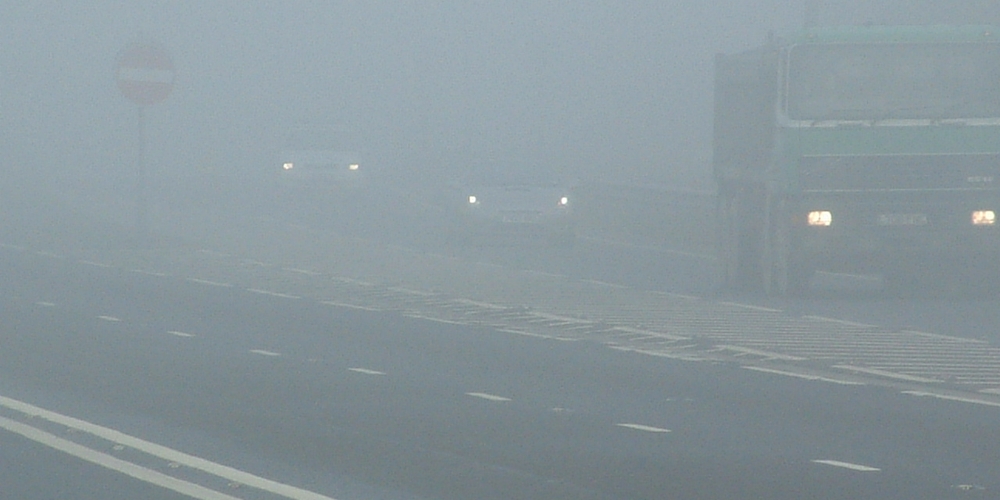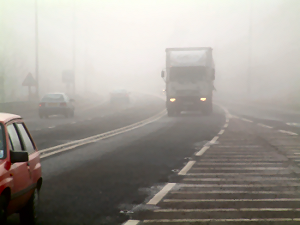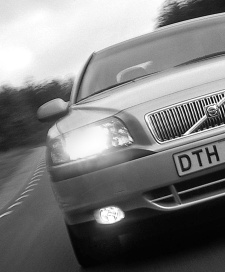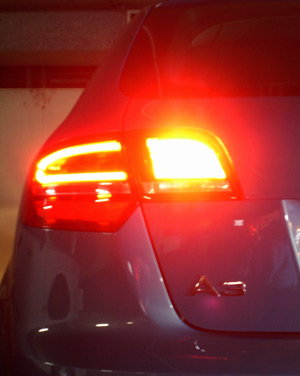
 Fog not only takes away a lot of what you would normally be able to see, it also distorts what you can see, making it difficult to assess speed and distance.
Fog not only takes away a lot of what you would normally be able to see, it also distorts what you can see, making it difficult to assess speed and distance.
The best advice is to avoid driving in fog whenever possible, if you can't avoid it, follow the guidelines in this information.
Fog is caused by moisture in the air turning into fine vapour droplets - this happens when the temperature drops to what is called the 'dewpoint'.
'Dewpoint' is simply a term which means that the air cannot hold all of its water as vapour and so the water becomes liquid.
Often you will see mist or fog forming on fields or around rivers, this is because of low ground temperature cooling the air. Effectively, fog is just a cloud at ground level. The seasons also affect the degree to which fog forms. Autumn is often described as the 'season of mellow fruitfulness' and is characterised by early morning mist.
A more scientific, but less poetic description might be 'the season of radiation fog'! (Caused by water evaporating from land and water and being affected by infra red cooling.) Fog can be made worse by pollution and so is thicker and more persistent some areas.
You must always use lights if visibility is less than 100 metres (by law). Your lights won't help you to see in foggy conditions, however, they help others to see you, therefore the more light you have, the better.
Use your headlights and fog lamps. Parking or dim-dip lights are as good as useless in daytime fog because they will not penetrate the vapour sufficiently. If the fog is really thick, use full headlights and spot-lamps - better still, stop for a cup of tea!
 Front fog lights
Front fog lights Your driving instructor perhaps never told you about front fog lights... Maybe he didn't know?
Front fog lights are usually mounted low down and give a broad flat beam. This reduces the amount of light that is reflected back by water droplets in the air. The most benefit from front fog lamps can be gained at night, especially on roads with street lighting.
Front fog lights will help you see the white lines and kerbs better - use them with dipped headlights (full lights are no use because the fog will simply reflect the light back making it harder to see). If the fog is really dense at night, switch off your headlights but leave on your front fog lamps other drivers will still be able to see you, but you will see more clearly because less light will be reflected back by the water vapour in the air (if the fog is really dense it's best not to drive).
Craze or just crazy? There seems to be a 'craze' amongst some drivers to use front
fog lights as driving lights when visibility is good. By doing this, you run the risk of dazzling other drivers who may the smash blindly into your car...
Using front fog lights in clear weather is an offence but the rules are rarely enforced.
 Lots of drivers put on their rear fog lights as soon as it starts to rain or when it gets is little misty. While I've no doubt that they do this with good intention it can cause more harm than good.
Lots of drivers put on their rear fog lights as soon as it starts to rain or when it gets is little misty. While I've no doubt that they do this with good intention it can cause more harm than good.
High intensity rear fog lamps are designed for thick fog, typically 100 metres or less visibility. Using rear fog lights when visibility is greater than this can mask your brake lights and dazzle other drivers, thus increasing the risk of a rear-end collision rather than reducing it. Constant, dazzling bright lights can also add to fatigue at night.
The UK Highway Code says:
Rule 226: You MUST use headlights when visibility is seriously reduced, generally when you cannot see for more than 100 metres (328 feet). You may also use front or rear fog lights but you MUST switch them off when visibility improves
Rule 236: You MUST NOT use front or rear fog lights unless visibility is seriously reduced as they dazzle other road users and can obscure your brake lights. You MUST switch them off when visibility improves.
When the word 'MUST' is used in The Highway Code it denotes a legal requirement.
It's helpful to think of rear fog lamps as signals. Switch on your rear fog lamps when there is no one close behind - but switch them off as soon as they have done their job and the driver behind can see your regular tail lamps*. For example, if you are in a slow moving queue of traffic in fog, the driver 5 metres behind doesn't need your fog lights!
*In the UK it is not a legal requirement to use rear fog lights when visibility is seriously reduced - however, non-use could possibly be considered as a contributory factor in the event of an accident in seriously reduced visibility.
 Although hanging on to the lights in front this might be seem to be the easiest way to cope with the fog, especially at night or if you are tired, it's a sure recipe for disaster.
Although hanging on to the lights in front this might be seem to be the easiest way to cope with the fog, especially at night or if you are tired, it's a sure recipe for disaster.
Because you can't see very far ahead you will have little or no warning if the vehicle ahead of you stops suddenly - this is especially the case if it is using rear fog lights which can mask the effect of brake-lights. This can be made worse by slippery roads (which often accompany fog).
Now you see me...
Another problem on high speed roads is that fog can drift, one moment you have reasonable visibility, the next moment, you can see nothing. It doesn't take a lot of imagination to think what might happen if the traffic ahead stops and you can't see it!
Occasionally you will see people driving fast and overtaking on foggy motorways - these drivers are under a false sense of security on two counts. First, as they drive fast their cars push the air ahead of them giving a false sense of visibility as the fog 'slipstreams' over the car. And second. the actually believe that the road ahead will be clear! Blind faith or what!!
Stay well back and allow yourself plenty of room to stop if necessary. It's all to easy to stop dead in fog.
Avoid using full beam in fog at night as the light will reflect back off the fog and reduce what you can see. Apart from dazzling the drivers in front, your full lights can throw a shadow in front of their vehicles making it harder for them to see.
Slow down - it's easy to get a false sense speed in fog so check your speedometer
At junctions, wind down your window and listen for other traffic - turning off the radio will help! Sound your horn to warn other drivers that you are there.
Check your speed often, especially on motorways and dual-carriageways - you may be increasing your speed without realising.
When you stop in traffic or at junctions, keep your foot on the brake pedal until you know that the driver behind has seen you.
Use your windscreen wipers and washers often and keep your de-misters switched on.
If the fog is really dense use the left edge of the road as a guide.
If you have to park, use a car park or other off-road location.
Remember S.A.S - your space and speed - watch your speed and leave extra space when driving in fog - and you'll arrive Safe and Sound!